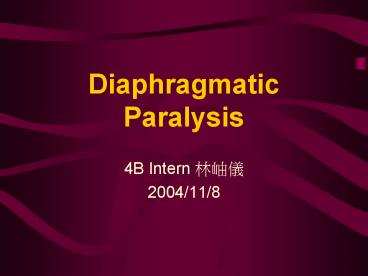Diaphragmatic Paralysis - PowerPoint PPT Presentation
1 / 32
Title:
Diaphragmatic Paralysis
Description:
leading cause of unilateral phrenic palsy (2-20%) left-sided: most frequently ... specific inflammations of the phrenic nerves (herpes zoster infection or vasculitis) ... – PowerPoint PPT presentation
Number of Views:2745
Avg rating:3.0/5.0
Title: Diaphragmatic Paralysis
1
Diaphragmatic Paralysis
- 4B Intern ???
- 2004/11/8
2
- Etiology
- Clinical features
- Diagnosis
- Treatment
- Prognosis
3
Etiology
4
Etiology-1
- Open heart surgery
- leading cause of unilateral phrenic palsy
(2-20) - left-sided most frequently
- harvest of internal mammary artery
- cold cardioplegia solution
- mechanical stretching
5
Etiology-2
- (2) Thoracotomy, pleurectomy, pneumonectomy
generally not accompanied by the risk - (3) Mediastinal and esophageal procedures
- (4) Trauma manipulation of the cervical spine,
penetrating injuries or surgery of the neck or
thorax, jugular or subclavian venous
catheterization, birth trauma - (5) Space-occupying lesions cervical
osteoarthritis, aortic aneurysm, substernal
thyroid, bronchogenic or mediastinal tumors
6
Etiology-3
- (6) Local inflammation pleurisy and pneumonia,
specific inflammations of the phrenic nerves
(herpes zoster infection or vasculitis) - (7) Mediastinal radiotherapy
- (8) Peripheral neuropathy diabetes
- (9) Neuralgic amyotrophy
- (10) Neuromuscular diseases multiple sclerosis,
anterior horn cell disease, acid maltase
deficiency
7
Clinical Features
8
Clinical Features- Unilateral paralysis
- Elevated hemidiaphragm in CXR
- Asymptomatic
- Dyspnea on exertion
- Decrease in exercise performance
- Orthopnea (less intense)
9
Clinical Features- Bilateral paralysis
- Severe exertional dyspnea, marked orthopnea
- Much worse supine
- Prolonged mechanical ventilation, tracheostomy
- Hypoxemia, atelectasis, chronic respiratory
failure, pneumonia, morbidity - Sleep disturbances
- Nocturnal hypoxia, worsening hypercapnia,
anxiety, daytime somnolence, morning headaches
10
Diagnosis
- PE
- CXR
- Sniff test
- PFT
- EMG
- Pdi
- PImax
11
PE
- Unilateral
- Dullness to percussion, breath sounds (-) over
the lower chest - Decreased excursion
- Bilateral
- Dullness with absent breath sounds, limitation of
diaphragmatic excursions - Tachypnea, accessory respiratory muscle use
- Diagnostic finding
- paradoxical inward movement of the abdomen with
inspiration
12
Diagnosis
- PE
- CXR
- Sniff test
- PFT
- EMG
- Pdi
- PImax
13
CXR
- Elevated hemidiaphragms
- Small lung volumes
- Atelectasis
- Strongly suggest the diagnosis of unilateral
diaphragmatic - paralysis
14
Diagnosis
- PE
- CXR
- Sniff test
- PFT
- EMG
- Pdi
- PImax
15
Sniff test
- Ultrasonography/ fluoroscopy
- Positive-
- paradoxical elevation of the paralyzed diaphragm
with inspiration
16
Diagnosis
- PE
- CXR
- Sniff test
- PFT
- EMG
- Pdi
- PImax
17
Pulmonary function test
- Unilateral paralysis mild restriction
- Bilateral paralysis severe restriction
- ?VC, MVV 55, 45 (inspiratory muscle weakness)
- ? FRC, RV 35-40 (pulmonary atelectasis)
- Supine VC lt 75 of upright
18
Diagnosis
- PE
- CXR
- Sniff test
- PFT
- EMG
- Pdi
- PImax
19
EMG
- One of the most specific tests
20
Diagnosis
- PE
- CXR
- Sniff test
- PFT
- EMG
- Pdi
- PImax
21
Transdiaphragmatic pressure
- Criterion standard for diagnosis
- (A) a thin-walled balloon at the lower end of the
esophagus (pleural pressure) - (B) a second balloon manometer in the stomach
- (intra-abdominal pressure)
- Pdi difference between A and B
22
Diagnosis
- PE
- CXR
- Sniff test
- PFT
- EMG
- Pdi
- PImax
23
Maximal inspiratory pressure
- PImax ?in parallel with Pdi
- Less negative than -60 cm H2O
- Not as specific as Pdi
24
(No Transcript)
25
Treatment
26
Treatment- Unilateral Paralysis
- Usually asymptomatic, rarely requires treatment
- Wait 3 months postoperatively for signs of
recovery - (Y. Deng, K. Byth and H.S. Paterson, Phrenic
nerve injury associated with high free right
internal mammary artery harvesting. Ann Thorac
Surg 76, 2003, pp. 459463)
27
Treatment- Unilateral Paralysis
- Diaphragmatic plication
- often necessary in infants
- (M. Tönz, L.K. von Segesser, T. Mihaljevic, U.
Arbenz, U.G. Stauffer and M.I. Turina , Clinical
implications of phrenic nerve injury after
pediatric cardiac surgery. J Pediatr Surg 31,
1996, pp. 12651267) - D.T.M. Lai and H.S. Paterson, Mini-thoracotomy
for diaphragmatic plication with thoracoscopic
assistance. Ann Thorac Surg 68, 1999, pp.
23642365
28
Treatment-Bilateral Paralysis
- Plication
- Bilateral plication reserved for irreversible
denervation with substantial paradoxical motion
documented by fluoroscopy - Mechanical ventilation nasal CPAP, intermittent
positive-pressure ventilation by nasal or oral
mask
29
Prognosis
30
Prognosis- Unilateral Paralysis
- Excellent, 1-18 months
- (P.G. Wilcox, P.D. Pare and R.L. Pardy, Recovery
after unilateral phrenic injury associated with
coronary artery revascularization. Chest 98,
1990, pp. 661666) - unless significant underlying pulmonary disease
- Return of diaphragmatic function
- Recruitment of other inspiratory muscles
(compensation) - Symptomatic patient s/p plication
- subjective and objective improvement
- (D.R. Graham, D. Kaplan, C.C. Evans, C.R.K. Hind
and R.J. Donnelly, Diaphragmatic plication for
unilateral diaphragmatic paralysis a 10-year
experience. Ann Thorac Surg 49, 1990, pp.
248252)
31
Prognosis-Bilateral paralysis
- Enhanced use of neck and rib cage inspiratory
muscles - Better pulmonary function in upright position
- Severe symptoms when lying down
- Often recover, 2 years
- (Olopade CO, Staats BA Time course of recovery
from frostbitten phrenics after coronary artery
bypass graft surgery. Chest 991112-1115, 1991)
32
Thanks for your attention!































